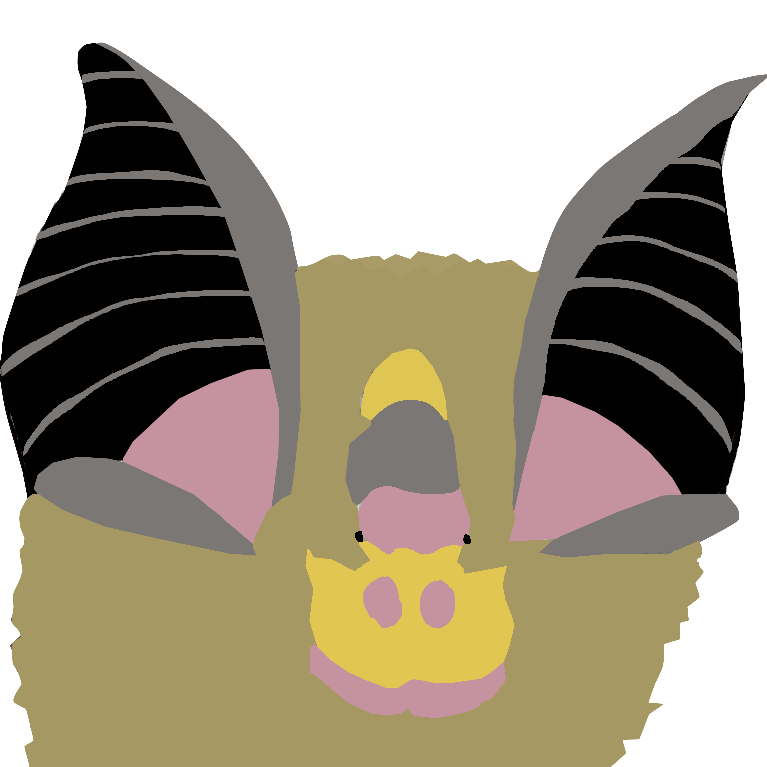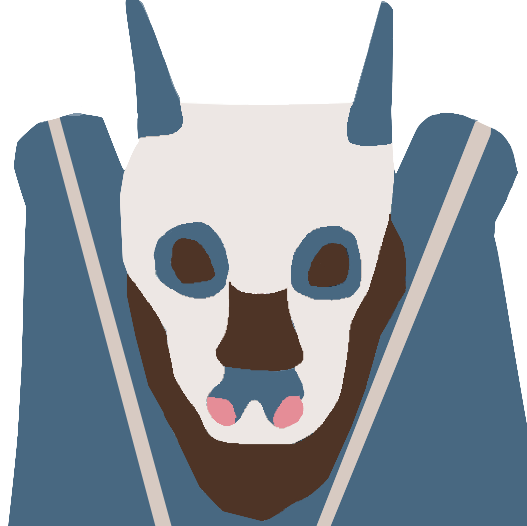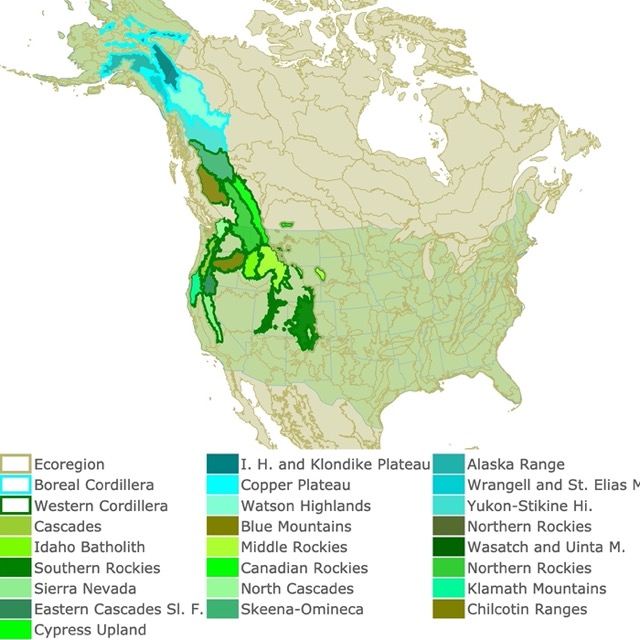Bat Habitat Map
This map shows the overlapping habitats of Chiroptera better known as Bats. The ring around the images has the colors of the different ecoregions, each group occupies. Due to range overlapping, a single group might have more than one color. Each image is a button that you can select to pick the distribution of a particular group. Zoom in the map to take a closer look! Hover to get the name of the ecoregion. For more information scroll down.
Bat Characteristics
Bats are Mammals that belong to the Order Chiroptera. "Chiro" from the Greek word for hand, and "Ptero" from the Latin word for wing.
This order has 21 families, 187 genera, and more than 1,300 species.
Bats are the only mammals capable of true flight. That is, flight powered by muscular movement and not from gliding.

Flight is accomplished by their specialized wings. Unlike other flying animals, their wings are made of their hand bones (the same bones that make up human hands)! A very thin and strong membrane connects the wing bones with the bat's legs, and from there to the tail.
The thumb is small, clawed and detached from the membrane. It helps bats cling to surfaces when it descends.
Bats hind legs are small and rotated. Their knees bend backwards, which helps them takeoff and fly.
Bats rest with their heads hanging down as they grasp from a twig or a crevice. They drop from this hanging position to take off.
Most bats are nocturnal, with a few species that are active at dawn and at dusk. Even though they see well, they rely primarily on their hearing.
Some of them use echolocation to avoid collisions and capture insects at flight. This is accomplished by emitting high-pitch sounds at about 100,000 hertz that echo from the objects they encounter.
Most bats have a single mating season in the year. They can be monogamous to polygamous.
Fun Facts About Bats
- The Kitti’s hog-nosed or bumblebee bat of western Thailand and southeast Burma is considered the world’s smallest mammal.
- The longest wing span is from the flying fox (member of the Pteropodoidea group). It can reach up to 6 feet (1.8m).
- Of about 1,300 bat species, only 3 feed on blood, and it is usually of cattle.
- Some bats travel up to 2,400 miles (3,900 km) to migrate each year. It is not clear how they navigate, but they go back to the same cave, they were the year before!
- Vampire bats may adopt orphaned young bats.
- Some plants don't germinate unless their seeds have passed through the digestive system of a bat.
- Bats make up over one fifth of mammal species on Earth.
- Bat ears can be five times the size of their head.
- The mother gives birth while hanging from her feet.
- It was not until Bela Lugosi’s 1930s portrayal of Dracula that the link between bats and vampires was first made.
- More than 10,000,000 Brazilian free-tailed bats Tadarida brasiliensis (Molossidae) have been found roosting together in single cave. These are the largest aggregations found among mammals!
Bat Habitat
Bats live in most ecosystems around the world. They are only absent from polar regions, distant islands, and extreme deserts, as shown on the map above.

Bats usually gather socially to rest in groups. This congregation or rest at night is called roost. This happens in tree hollows, caves, or man-made structures like bridges. (I grew up in the Colombian Caribbean region, and it was not rare to find bats inside the classrooms in the morning!)
They may also make tents of leaves and sleep under them, still hanging from a tree. Others are solitary, with mother and pup making the largest aggregations.
Bat diversity is greatest in the tropics and subtropics. In areas like Colombia, you can find up to 150 species. While in SE Asia or equatorial Africa you can find around 100 species. In Newfoundland, Canada there are only 2 species. In Hawaii one, and in French Polynesia none.
Some bats hibernate during the winter, while others migrate to warmer areas.
The ability to fly and echolocate may be the reasons for the adaptive radiation of bats.
US Bats
There are 47 bat species in the United States. As shown in the map they are everywhere, except in northern Alaska.
The largest bat in North America is Eumops perotisthe, also known as the Western mastiff, western bonneted bat, the greater mastiff bat, or the greater bonneted bat.
The Western mastiff bat is a member of the free-tailed bat family, Molossidae, and its wing span is of 22 inches (56 cm).
The hoary bat Lasiurus cinereus member of the Vespertilionidae family is the most common bat in the United States, San Diego Zoo.
Bat Diet
Most Bats eat insects. Some predatory bats eat arthropods as well as vertebrates like fish, frogs, reptiles, birds, mammals, and even other bats!
In tropical and subtropical regions bats eat plant material like leaves, fruit, nectar, and pollen.
Vampire bats eat only the blood of living vertebrates. They have the most specialized diets. The three species that drink blood occur in Central and South America. One of this species Desmodus rotundus (Phyllostomidae) drinks blood of humans sleeping, Cell.
Bat Groups and Classification
Bats used to be classified in two major groups Megachiroptera and Microchiroptera. This classification was mainly based on their physical characteristics.
Megachiroptera, were the big and medium size bats. Megachiroptera also included bats that ate fruit, nectar, pollen and small animals. They included as well bats that had big eyes and great eyesight. This bats had no echolocation.
Microchiroptera were the small bats that mainly ate insects. They were also identified by their echolocation for flying and finding their prey.
This classification assumed that echolocation appeared in only one group. Recent genetic analysis suggest that Michrochiropera is more than one group and that echolocation was lost in Pteropodiformes group Nature.
Based on this new molecular genetic data, Bats are classified into two new major groups: Yinpterochiroptera and Yangochiroptera.
The table below shows the two new suborders and the families in each group. ITIS
| Order | Suborder | Superfamily | Family |
| Chiroptera | Yinpterochiroptera | Rhinolophoidea | Rhinolophidae: Horseshoe bats |
| Rhinopomatidae: Mouse-tailed bats | |||
| Rhinonycteridae: Trident bats | |||
| Craseonycteridae: Hog-nosed bat | |||
| Megadermatidae: False vampires | |||
| Hipposideridae: Old World leaf-nosed bats | |||
| Pteropodoidea | Pteropodidae: Old World Fruit Bats, Flying Foxes | ||
| Yangochiroptera | Emballonuroidea | Emballonuridae: Sheath-tailed bats | |
| Nycteridae: Slit-faced bats | |||
| Noctilionoide | Noctilionidae: Bulldog bats | ||
| Myzopodidae: Madagascar sucker-footed bats | |||
| Mystacinidae: New Zealand short-tailed bats | |||
| Thyropteridae: Disk-winged bats | |||
| Furipteridae: Smoky bat and thumbless bat | |||
| Mormoopidae: Ghost-faced, naked-backed and mustached bats | |||
| Phyllostomidae: New World leaf-nosed bats | |||
| Vespertilionoidea | Vespertilionidae: Vesper bats | ||
| Natalidae: Funnel-eared bats | |||
| Cistugidae: Wing-gland bats | |||
| Miniopteridae: Free-tailed bats | |||
| Molossidae: Free-tailed bats |
Yinpterochiroptera
Yinpterochiroptera or Pteropodiformes is a suborder of Chiroptera. This suborder includes the megabats and a few of the microbat families.
Yinpterochiroptera is composed of 2 superfamilies Rhinolophoidea and Pteropodoidea.
This suborder has echolocation ability, with the exception of the Peropoidea superfamily.
Rhinolophoidea
The bats of this superfamily inhabit only the Old World. They are mainly present in northern and central Africa, southeast Asia (the center of their diversity), and northwestern Australia.

They live in open space areas like above canopy forests and clearings to tight maneuvering places like fern thickets.
The majority of these bats are insectivores and catch their prey on the wing, Rhinolophoid Bats.
The largest family in this group is Rhinolophidae, with 10 genera.
They occur in arid and semiarid habitats, where they roost in large numbers in caves, openings in rock walls, and man-made structures including houses, wells, tunnels, and tombs.
They are characterized by a transverse dermal ridge on the nose above the nostrils. Source: tolweb.org
Pteropodoidea
This superfamily has only one family Pteropodidae. They do not use echolocation. They are also called Megabats, Old World fruit bats or Flying foxes. This is obviously because of their looks and size.

This family has the largest bat Pteropus vampyrus with a wing span of 6 feet (1.8m), and the heaviest bat Pteropus giganteus with males weighing up to 3.52 pounds (1.6 kg).
Pteropodidae has a tropical and subtropical distribution in the Old World. Half of the 41 genera roost in trees.
Pteropodids are strictly vegetarian. They forage fruits, nectar, and pollen using their sight and a sensitive olfactory system. They play an important role as pollinators and seed dispersers.
Some members migrate great distances while others stay in a smaller range. Source: AnimalDiversity.org
Yangochiroptera
Yangochiroptera, or Vespertilioniformes, is a suborder of Chiroptera
These bats use laryngeal echolocation to avoid obstacles and hunt for food.
Emballonuroidea

Emballonurids are also known as sheath-tailed bats and sac-winged bats. This is because of the glandular sac found on the edge of the wings in many species. The sac is used to produce a scent which represents territorial dominance and social presence.
They are found in tropical and Subtropical areas around the world.
Noctiloinoidea

Many of Noctiloinoidea bats have particular facial ornamentation, including nose-leaf, leaf-chin flaps, big lips, and other projections in the lip and nasal region. Source: tolweb.org
This superfamily has a varied food preference among its species. Some specializing in insects, rodents, birds, nectar, fruit, or blood.
Vespertilionoidea

Vespertilionoidea or Evening Bats, are insectivorous, and most catch their prey in the air while flying. Some species, may trawl with their hind feet across lakes or streams to catch their food.
One conspicuous species from this group was already mentioned before for its large colonies, is the free-tailed Mexican bat or Tadarida brasiliensis. This bat is part of the Molossidae family and it is quite prominent in California and Texas.
Best Places to See Bats in the USA
Even though some species of bats are threatened, it is possible to admire them in their natural habitat. This is acceptable as long as guidelines to ensure their safety are followed, and their environment is not disturbed. Source: Batcon.org
- Bracken Cave, Texas: This location is close to San Antonio. It is possible to observe bats in this area at dawn and at dusk. The cave is owned by Bat Conservation International (BCI). It holds a large colony of bats, however, visitors are not allowed. Only members BCI can observe them on different dates. There are 2 public nights, but they are booked quickly.
If you are ready to book a place in San Antonio, I suggest you stay near San Antonio's Riverwalk. You can enjoy the best of the River Walk before you go for a wildlife adventure. For more information check Hotels.com. - Congress Avenue, Texas: Right under Congress Avenue bridge, in downtown Austin. This is the largest urban colony in the world. About 1.5 million Mexican free tailed female bats live under the bridge. They migrate in spring and leave through the fall.
If you are interested in witnessing these bats fly off the bridge, I suggest you stay in Austin. Several sofisticated hotels are close to most venues in Austin, and a few minutes walk from Congress bridge. This great location can be booked at Hotels.com. For more details Click Here!. - Carlsbad Caverns, New Mexico: This is an UNESCO World Heritage Site, and a National Park. These caverns are also visited by the free-tailed Mexican bats during the summer. You cannot enter the caverns but you can observe the bats out flight.
- Yolo Causeway, California: This is where California's largest colony of free-tailed Mexican bats spend their summer. It is possible to see them at a wildlife area with a tour. But it is also possible to see them while driving the causeway!
For airline tickets to Sacramento go to Expedia. - Millie Mine, Michigan: Located near Iron Mountain. The bats emerge from their roosts in an abandoned iron ore mine. The entrance is not very big and hides a mine shaft of 360 feet. The mine provides a site for mating in the summer and hibernating in the winter.
- Nickajack Cave, Tennessee: Close to Chattanooga, this cave is home to a colony of gray bats. Even though the entrance is gated, visitors can see the bats emerge. In fact it is possible to see the bats from kayaks and canoes while bats fly over the reservoir.
When visiting, always remember to be respectful of bat habitats. Leave sites as you find them. Caves and mines are not to be disturbed in winter when bats are resting. Decontamination protocols need to be followed year-round, sodesinfect your gear to prevent cross contamination, and prevent fungal growth.
Bat Threats
In the United States bats face different threats. These including climate change, habitat loss, infectious disease, and wind energy production.
These threats are so acute that it makes bats the most threatened land mammal in North America.
Recently bat populations have declined due to the effect of white-nose syndrome. This is a fungal disease that affects different bat species.
Wind turbines seem to affect mainly migratory bats like the hoary bat due to higher chances of collision. Source: Defenders.org
Bats have been killed on purpose when people disturbed their caves or hunted them for food or medicine.
Bats may be involved in the epidemiology of diseases such as rabies, histoplasmosis, Ebola, Nipah and SARS. These diseases cast a darker shadow on these all too often maligned mammals.
Bat Importance
Bats are important as they are responsible for pollinating. They are also responsible for spreading seeds.
They pollinate, dates, figs, peaches, avocados, bananas, and mangoes!
Because they may feed on insects, bats are great as pest control.
Resources for Bat Groups Map
Regardless of the distribution shown here, most of it is probable, since most of their natural habitat is scattered or affected by human populations.
Most of the bat superfamilies distribution was obtained from http://people.wku.edu/ and from toweb.org.
The shapefiles to create the map with ecoregions of the world were obtained from WWF. The shapefiles with the countries of the world were obtained from Natural Earth.
This map will be updated with new data! To receive updates on this and more nature maps, join my email list!!!!!!!
Made by Luz K. Molina with D3.js.









